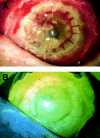Amniotic membrane transplantation for ocular surface reconstruction
- PMID: 10434859
- PMCID: PMC1723001
- DOI: 10.1136/bjo.83.4.399
Amniotic membrane transplantation for ocular surface reconstruction
Abstract
Aims: To evaluate the efficacy of amniotic membrane transplantation (AMT) for ocular surface reconstruction.
Methods: 10 consecutive patients who underwent AMT were included. The indications were: group A, cases with persistent epithelial defect after corneal abscess (n = 1), radiation (n = 1), or chemical burn (n = 3); group B, cases with epithelial defect and severe stromal thinning and impending or recent perforation, due to chemical burn (two patients, three eyes) or corneal abscess (n = 2); group C, to promote corneal epithelium healing and prevent scarring after symblepharon surgery with extensive corneo-conjunctival adhesion (n = 1). Under sterile conditions amniotic membrane was prepared from a fresh placenta of a seronegative pregnant woman and stored at -70 degrees C. This technique involved the use of amniotic membrane to cover the entire cornea and perilimbal area in groups A and B, and the epithelial defect only in group C.
Results: The cornea healed satisfactorily in four of five patients in group A, but the epithelial defect recurred in one of these patients. After AMT three patients underwent limbal transplantation and one penetrating keratoplasty and cataract extraction. In group B amniotic membrane transplantation was not helpful, and all cases underwent an urgent tectonic corneal graft. Surgery successfully released the symblepharon, promoted epithelialisation and prevented adhesions in the case of group C.
Conclusion: AMT was effective to promote corneal healing in patients with persistent epithelial defect, and appeared to be helpful after surgery to release corneo-conjunctival adhesion. Most cases required further surgery for visual and ocular surface rehabilitation. Amniotic membrane used as a patch was not effective to prevent tectonic corneal graft in cases with severe stromal thinning and impending or recent perforation.
Figures


Comment in
-
Amniotic membrane transplantation in ophthalmology (fresh v preserved tissue).Br J Ophthalmol. 1999 Dec;83(12):1410-1. doi: 10.1136/bjo.83.12.1409b. Br J Ophthalmol. 1999. PMID: 10574825 Free PMC article. No abstract available.
References
MeSH terms
LinkOut - more resources
Full Text Sources
Other Literature Sources
Medical
